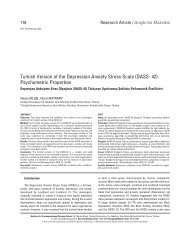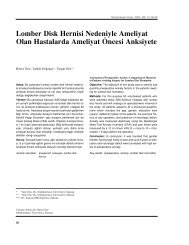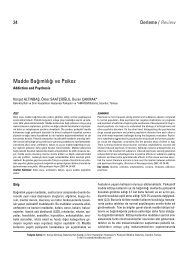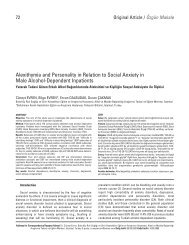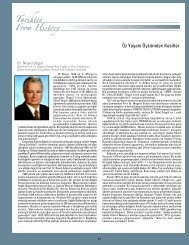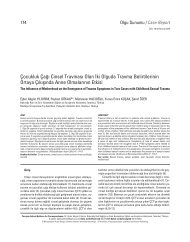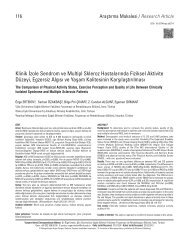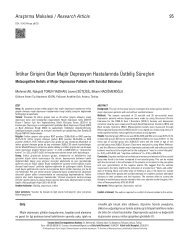A Case of Myoclonic Symptoms After Streptococcal Infection
A Case of Myoclonic Symptoms After Streptococcal Infection
A Case of Myoclonic Symptoms After Streptococcal Infection
Create successful ePaper yourself
Turn your PDF publications into a flip-book with our unique Google optimized e-Paper software.
86<br />
In this report, we present the case <strong>of</strong> a fifteen-year-old<br />
adolescent who had myoclonic symptoms in the shoulders<br />
and was initially treated for epilepsy and later, for conversion<br />
disorder until the diagnosis <strong>of</strong> PANDAS was established.<br />
<strong>Case</strong><br />
Ceylan et al.<br />
A <strong>Case</strong> <strong>of</strong> <strong>Myoclonic</strong> <strong>Symptoms</strong> <strong>After</strong> <strong>Streptococcal</strong> <strong>Infection</strong>: Possible PANDAS Variant<br />
A fifteen-year-old male had been evaluated at the<br />
emergency department with complaints <strong>of</strong> nausea and involuntary<br />
movements <strong>of</strong> the shoulders a week after oropharyngeal infection<br />
and high temperature. These symptoms had been considered<br />
relevant to a diagnosis <strong>of</strong> encephalitis or an epileptic disorder.<br />
Because the cerebrospinal fluid (CSF) findings had been<br />
completely normal, encephalitis had been ruled out. Cranial MRI<br />
and Electroencephalographic (EEG) assessment were without<br />
any abnormalities. <strong>After</strong> initiating diazepam infusion, the<br />
symptom <strong>of</strong> myoclonus had been controlled, hence, the patient<br />
had been administered valproic acid at a dose <strong>of</strong> 500 mg per day<br />
for the diagnosis <strong>of</strong> myoclonic epilepsy and had been discharged<br />
after the disappearance <strong>of</strong> myoclonic seizures. Five days later,<br />
the myoclonus had reappeared, so the dose <strong>of</strong> valproic acid had<br />
been increased to 1000 mg per day, but with no response. In<br />
spite <strong>of</strong> adding clonazepam 2 mg/day to the existing<br />
pharmachotherapy, the myoclonus had persisted and showed<br />
periodic pattern.<br />
The patient was admitted to our outpatient clinic six months<br />
after the onset <strong>of</strong> symptoms. Because there was no enough<br />
response to antiepileptic treatment and sometimes the<br />
symptoms were exacerbated by stressor factors, we requested<br />
a consultation by the neurology department regarding the<br />
possibility <strong>of</strong> conversion disorder. The last EEG assessment was<br />
completely normal and the patient was prescribed sertraline 50<br />
mg per day for the diagnosis <strong>of</strong> conversion disorder. The patient<br />
has been followed up at the neurology and psychiatry<br />
departments for ten months exhibiting the same symptom<br />
severity.<br />
At the final evaluation, it was found out that the symptoms<br />
initiated after a high temperature and oropharyngeal infection<br />
and also continued in an episodic pattern. Additionally, it was<br />
understood that myoclonic symptoms followed skin lesions<br />
determined to be pyogenic lesions. Skin swabs were taken for<br />
culture by a dermatologist and were positive for streptococcal<br />
infections, while the throat culture was negative.<br />
Therefore, PANDAS myoclonic type has been suspected<br />
and determination <strong>of</strong> Antistreptolysin-O (ASO) titer was<br />
recommended. Because <strong>of</strong> the fact that the value <strong>of</strong> ASO was<br />
high (345 IU/ml), all psychiatric and neurological treatments<br />
were stopped and intramuscular (IM) penicillin treatment was<br />
suggested for five days. Moreover, considering the probability <strong>of</strong><br />
acute RF, the rheumatology department was consulted, but this<br />
diagnosis was not confirmed due to absence <strong>of</strong> other symptoms<br />
<strong>of</strong> RF.<br />
The myoclonus <strong>of</strong> the shoulders resolved completely with<br />
penicillin therapy. Two months later, ASO titer was measured<br />
again and was as high as the prior one. Thereupon, it was<br />
decided that continuing penicillin prophylaxis (1.200.000 IU /<br />
once every three weeks) was needed.<br />
During the six-month follow-up period, the patient had no<br />
complaints and continued his life in a healthy manner.<br />
Discussion<br />
Archives <strong>of</strong> Neuropsychiatry 2011; 48: 85-7<br />
Nöropsikiyatri Arflivi 2011; 48: 85-7<br />
In this report, we note that it is hard to recognize the<br />
myoclonic variant <strong>of</strong> PANDAS in late-onset cases. According to<br />
the diagnostic criteria <strong>of</strong> PANDAS, the symptom onset must<br />
be between 3 years <strong>of</strong> age and puberty (7). The case presented<br />
here does not meet the PANDAS criteria, but as there are cases<br />
with even later onset, described as adult-onset variant <strong>of</strong><br />
PANDAS, we suggest that late onset can not be an exceptional<br />
feature (8). Additionally, the sudden onset must be taken into<br />
consideration as a supporting detail.<br />
In the literature, there are few reports involving no tics and<br />
obsessive-compulsive symptoms, but only myoclonus (9,10).<br />
Pavone et al. noted that existence <strong>of</strong> OCD/tic disorders may not<br />
be essential in PNADAS variant cases (5). The most common<br />
autoimmune neuropsychiatric disorders associated with<br />
streptococcal infections include Tourette’s syndrome,<br />
Sydenham’s chorea, classic PANDAS and PANDAS variants (5).<br />
In all these disorders, the symptoms vary, but the etiology is<br />
almost the same. In each, it is hypothesized that antibodies<br />
produced as part <strong>of</strong> an immune response to GABHS surface<br />
proteins have antigenic similarities to central nervous system<br />
proteins (molecular mimicry) in susceptible persons. Genetic<br />
and familial factors may also play a role in the pathogenesis <strong>of</strong><br />
PANDAS. It has been found in RF that certain families have a<br />
higher incidence <strong>of</strong> a monoclonal antibody, D8/17. Similarly,<br />
patients with PANDAS have been shown to have similar<br />
elevations <strong>of</strong> D8/17 (4).<br />
The major clinical manifestations include tics and obsessivecompulsive<br />
symptoms in PANDAS. This type <strong>of</strong> neuropsychiatric<br />
symptoms is also observed in Sydenham’s chorea, which is the<br />
only recognized neurological manifestation <strong>of</strong> RF. It is seen in<br />
about 20% <strong>of</strong> patients with acute RF and most <strong>of</strong>ten occurs<br />
weeks to months after group A streptococcal infection (11).<br />
PANDAS patients do not present with classic choreiform<br />
movements or other symptoms <strong>of</strong> RF, but only with tics and/or<br />
obsessive-compulsive symptoms (12). Therefore, a detailed<br />
anamnesis and exploration are necessary and caution should be<br />
applied not to miss a RF.<br />
Our case does not represent a classical PANDAS/PANDAS<br />
variant case, but it is obvious that the myoclonic symptoms<br />
were associated with streptococcal infection. Therefore, our<br />
case points out the need for re-evaluation <strong>of</strong> PANDAS variant<br />
criteria in the future.<br />
Treatments including penicillin prophylaxis, intravenous<br />
immunoglobulin, plasma exchange, tonsillectomy are useful in<br />
this spectrum (1,13). Similarly, our case did not respond to<br />
antiepileptic and antidepressant treatment, but responded to<br />
penicillin.



